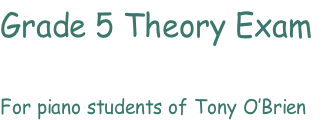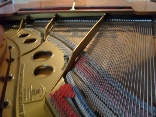


12
Ornaments
Questions on ornaments rarely come up as part of question 1 or 4. You will either need to name the ornament from its sign/symbol (easy) or replace a written out ornament with its appropriate symbol or sign (more difficult).
You only need to know the following ornaments -
When writing the ornament take care with any accidentals as shown below.

The grace note (little note-
So if you see
1 note bracketed with a duration equal to or longer than the next note
or, as here,
2 notes bracketed with the same or nearly the same duration,
you know to replace the bracket with an appoggiatura.
If there’s an accidental on the first note make sure to include it on the grace note.
The grace note has a diagonal line through its stem, and is played just before the principal note.
So if you see just
1 note bracketed with a vary short value
or, as here,
2 notes bracketed, and one has a very short duration just before a beat or half beat,
you know to replace is with an acciaccatura on the next note after the bracket.


This is 3 note ornament using the principal note and the note above, or, if inverted, as shown by a vertical line, the principal note and the note below. Accidentals on the note above or below are shown above or below the ornament.

If the first note of the tell-

This is 4 note ornament using the principal note, the note above, and the note below. If written directly above the principal note, it start on the note above, unless it’s an inverted turn (vertical line), in which case it starts on the note below. Accidentals can be used both above and below the ornament as shown above.


Don’t worry too much about actual note durations, since the turns could be written
out in many different ways as in the example above -


If 5 notes are bracketed, the first of which has longer duration than the others, this suggests a turn written after the principal note but before the next note. In the case, the principal note is first played and then the notes of the turn.


Loads of notes written on the principal note and the note above, which can take an
accidental. Don’t worry about how many notes, their duration or whether the trill
starts on the principal note of the note above -
